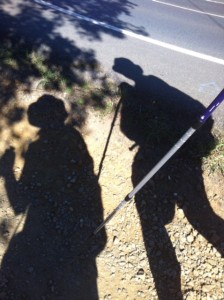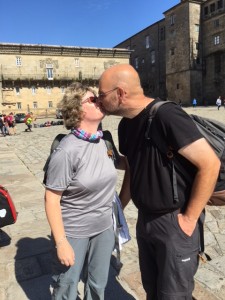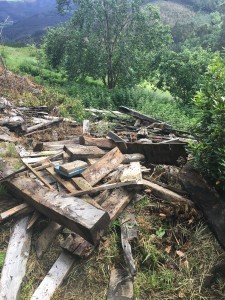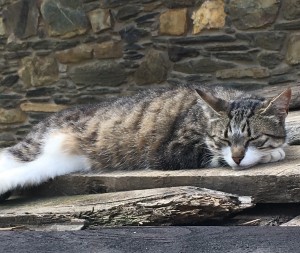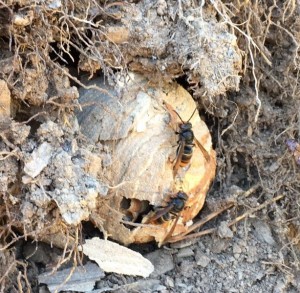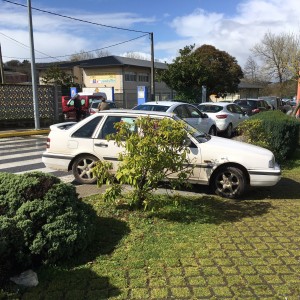I’ve mentioned our water problems before. For a first world country we have our fair share of third world problems, and a summer lack of water is one of them. Despite us living in the wettest part of Spain, with on average more precipitation in a year than Manchester, the local village water supply has a habit of running low, or even totally dry during late summer.
The first year that this happened our neighbour Carlos was more than happy to hand me the keys to the deposit, a symbolic gesture as the door hasn’t locked for years, and give me the responsibility for strimming it’s immediate surrounds, and also keeping an eye on the springs about five kilometres away in the mountains.
I’ve been doing my duty and monitoring the levels since early summer and was surprised at how well our village has done. Our local, 50,000 litre, deposit was full throughout September and early October and it was only on the last few days of the month that the level started to drop a little.
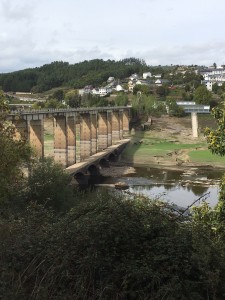 It’s been a very dry summer, which made our decent water situation even more surprising. When we walked the Camino at the end of September it was startling to see the level of the river as we approached Portomarin. As you can see in the photograph the river is usually at the level indicated by the change of colour on the modern day bridge pillars but after the summer we’ve had you could even see the old medieval bridge on the river bed.
It’s been a very dry summer, which made our decent water situation even more surprising. When we walked the Camino at the end of September it was startling to see the level of the river as we approached Portomarin. As you can see in the photograph the river is usually at the level indicated by the change of colour on the modern day bridge pillars but after the summer we’ve had you could even see the old medieval bridge on the river bed.
We’ve essentially had six months with only a smattering of rain, people haven’t been able to water their allotments or wash their cars, and now we are paying the price.
At the start of November the level in our deposit started to drop, at an alarming rate. Over the space of seven days it went from 80% full to 80% empty, we had a problem and it needed investigation and action.
In autumn, winter and spring this local water store usually receives around 750 litres per hour from the springs but on taking a measurement (involving blocking the outflow, sticking a bucket under the overflow, and measuring with a stopwatch) we measured the flow at just 200 litres per hour.
One of the three springs had dried completely and the other two were running vastly under normal flow. There were also some minor leaks with water escaping, and we needed every drop that we could get. I scoured the internet for solutions to plug a leak in a concrete tank without turning off the essential supply. I looked as expanding foam, silicon, and putty but none of them fitted the bill or gave me any confidence of a permanent solution.
Then I had a moment of enlightenment, hydraulic cement. A local supplier had a bag, and opened on a bank holiday to sell me it, and it’s miraculous. You mix it in small quantities, and have to use it as soon as it is mixed. Once in place it ‘goes off’ in three minutes, or under water in five…chisel hard. So with the help of a neighbour I made the repairs and everything that could be done to safeguard the supply had been done.
Phase two of the operation then had to kick in.
Amanda produced a leaflet explaining the situation and asking the neighbours to be careful with their use of our precious resource. As most are Gallego speaking, octogenarians they do have some problems understanding as you can tell by the way their lips move when they try to read. So in hand-delivering our ‘Public Information’ bulletins we had to explain the situation verbally.
It didn’t work.
Consumption continued unabated and over the next few days and the flow from springs fell even further, down to 150 litres per hour. So then I flexed my English muscles and cut everyone off.
If I’ve got the keys, and I do the housekeeping and repairs, then I think I’ve the right to operate the big supply taps! We started with a water curfew between 9pm and 9am and we are now down to a 4pm to 10am prohibition. In just six hours a day we are using all of the water which comes in during the eighteen hours of closure. We are holding at 20% full but with no rain on the long range forecast I am afraid that a gradual reduction on hours is on the cards as I try to avoid a total water wipeout.
We’re not alone. Across Spain the reservoirs are at 30% and falling. Some local villages have been without water since mid-summer and one local town now has a nighttime cut to supplies, seven days a week.
If anyone knows a good rain dance, or can rent us a cloud-busting machine, then give me a shout. We are getting desperate.


